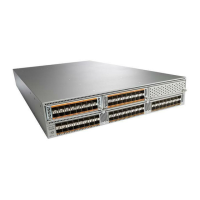In Cisco Nexus devices, the BB_credit mechanism is used on Fibre Channel interfaces but not on virtual Fibre
Channel interfaces. The receive BB_credit determines the receive buffering capability on the receive side
without having to acknowledge the peer. This is important for links with large bandwidth-delays (long links
with large latency) to be able to sustain line-rate traffic with increased latency.
For virtual Fibre Channel interfaces, BB_credits are not used. Virtual Fibre Channel interfaces provide flow
control based on capabilities of the underlying physical Ethernet interface.
Note
Configuring Fibre Channel Interfaces
Configuring a Fibre Channel Interface
To configure a Fibre Channel interface, perform this task:
SUMMARY STEPS
1.
switch# configuration terminal
2.
switch(config)# interface {fc slot/port}|{vfc vfc-id}
DETAILED STEPS
PurposeCommand or Action
Enters configuration mode.switch# configuration terminal
Step 1
Selects a Fibre Channel interface and enters interface configuration mode.switch(config)# interface {fc
slot/port}|{vfc vfc-id}
Step 2
When a Fibre Channel interface is configured, it is automatically
assigned a unique world wide name (WWN). If the interface’s
operational state is up, it is also assigned a Fibre Channel ID (FC
ID).
Note
Configuring a Range of Fibre Channel Interfaces
To configure a range of Fibre Channel interfaces, perform this task:
SUMMARY STEPS
1.
switch# configuration terminal
2.
switch(config)# interface { fc slot/port - port [ , fc slot/port - port ] | vfc vfc-id - vfc-id [ , vfc vfc-id -
vfc-id ] }
Cisco Nexus 5000 Series NX-OS SAN Switching Configuration Guide, Release 5.2(1)N1(1)
16 OL-27583-01
Configuring Fibre Channel Interfaces
Configuring Fibre Channel Interfaces

